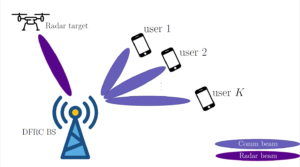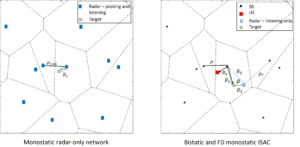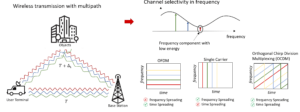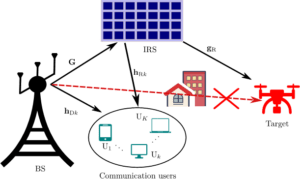Research Topics
Power Budget Study for ISAC
Waveform Design for Monostatic ISAC
One of the major challenges in monostatic ISAC is the full-duplex operation due to the self-interference caused by the physical placement of the transmit and receive antennas. While there are typical approaches in the literature tackling this issue via analog and digital cancellation, this issue remains a practical barrier. This research seeks to solve this problem in the waveform domain by employing zero-padded (ZP) modulation instead of a typical cyclic prefix (CP). In short, while there is no transmission, the radar receiver can listen to the radar channel free of self-interference, thereby enabling monostatic radar processing without the need for complex analog and digital cancellation methods. This research aims to compare the radar performance of ZP and CP waveforms when the CP-based schemes implement an imperfect and realistic cancellation method. The results demonstrate that for the OFDM transmission with low-complexity energy detection radar method for some practical scenarios with 20% of CP overhead, the CP system has at most only 17% more detection range than the ZP. When CP-OFDM has imperfect self-interference cancellation, the detection range can be worse than ZP-OFDM, demonstrating the practical appeal of employing ZP-based waveforms in monostatic sensing settings.
Frame Design for Bistatic Sensing
A big challenge of bistatic sensing is the knowledge of the radar of the transmitted signal. The most simple approach is to introduce sensing pilots among the data blocks such that the radar receiver does not need to know the data, but performs sensing only using these dedicated time and frequency slots. Naturally, the drawback of such an approach is that the communication data rate is sacrificed. Alternatively, the radar can use the data blocks to perform sensing, but such an approach can be either highly complex or infeasible in practice since it demands a dedicated link between the transmitter and the radar receiver or a full communication receiver to replicate the waveform. In summary, both dedicated pilots and data block-based processing have their drawbacks. In this work, we address the aforementioned issues by substituting the CP with known signals termed unique word (UW). The motivation behind this approach is that the UW replacement does not incur data rate loss for the communication systems as in the dedicated pilot approach while allowing a per-block radar processing as in the case of using the data blocks. When compared to the dedicated pilot approach, the proposed UW-based radar processing solution presents a competitive performance without sacrificing the data rate, with even better performance depending on the frame configuration. In comparison to the daya block-based processing, the UW schemes are worse, but with the advantage of not needing the knowledge of data, thereby being more appealing for practical deployments.
Waveform Design for Integrated Sensing and Communications (ISAC) 6G Systems

6G is intended to foster a wide scope of services, spanning haptic telemedicine to VR/AR remote services and holographic teleportation with massive eXtended reality (XR) capabilities, as well as Blockchain, just to name a few. Therefore, 6G will go beyond communications, thanks to a key feature that is ISAC. Indeed, ISAC cooperation and convergence is an utmost topic that will serve as a door-opener for innovative applications in several domains such as automotive sector, UAV sector and robotics. Spectrum efficiency is one of the major virtues of ISAC, as the dynamics of sensing and communication can be “buckled up” within the same resource. An additional advantage is hardware resource sharing between radar and communication tasks, thus having both sensing and communication on a single platform will lead to reduced PHY-layer modem size and cost. All these merits give rise to a serious number of challenges and research questions that need to be addressed, such as efficient resource reuse and spectrum sharing, trade-offs between high communication rates and high-resolution sensing performances, privacy and security, and shared waveform design from a practical standpoint.
In this project, we focus on practical waveform design, which puts forward dual-functional radar and communication base stations on the forefront of future 6G cellular networks. The main essence lies in providing efficient algorithms and designs through suitable optimization frameworks, enabling fruitful trade-offs, given the conflicting natures of the sensing and communication objectives. Even more, these methods should adapt to model uncertainties, such as situations with imperfect channel state information, and hardware imperfections, such as high power amplifier considerations.
ISAC in Large Networks using Stochastic Geometry

As real-world networks become more and more dense, the impact of the intercell interference coming from the entire network is significant. Incorporating this is crucial for accurate modeling of the impact of any current and future technologies to be deployed.
Radar and communication have advanced in parallel without intersection for decades. Both network communication and sensing requirements, however, are growing and spectrum is scarce. It is thus natural to consider having radar and communication share spectrum. Integrated sensing and communication (ISAC), in particular, aims to use the same signal for both sensing and communication in the same channel, at the same time.
In this project we focus on using stochastic geometry tools to model large networks that deploy ISAC. We focus on performance analysis, optimizing network parameters to meet different network goals and objectives, and propose strategies to improve both radar and communication performance in ISAC.
Highly Selective Wireless Channels

With the recent advancements of wireless networks to satisfy new requirements, the investigation of novel transmission schemes to improve the link level performance is of major importance. In order to overcome the negative effects caused by the wireless channel dispersion, a typical approach is to spread the energy of data symbols over the time and frequency domains. However, this comes at a cost in terms of losing orthogonality among data symbols, which requires more sophisticated receivers to be employed to deal with additional interference.
In this context, we focus on designing waveforms (precoders) with iterative equalization and study their performance and complexity trade-offs. In particular, we are interested in investigating this topic considering integrated sensing and communication (ISAC) and multiple-input multiple-output (MIMO) aspects.
Physical Layer Security for Integrated Sensing and Communication

The sixth-generation (6G) wireless standard is being developed not only to improve the quality of user experience compared to that offered by the fifth-generation networks, but also to support a range of new wireless communication services, such as autonomous vehicles, drone monitoring, human activity recognition, environmental monitoring, enhanced localization and tracking, and many more. Supporting such new services will require the integration of communication, sensing, and localization capabilities as fundamental services in a single network architecture rather than as auxiliary functionalities. Integrated sensing and communication (ISAC) has recently emerged as a potential enabler in this direction, combining the communication and sensing capabilities in a single hardware platform using a common waveform. Preliminary results have confirmed that ISAC can improve the spectral efficiency of a network by virtue of exploiting common hardware, signal processing, and spectral framework, thereby offering a low-cost solution to the spectrum scarcity problem. Furthermore, by exploiting the possibility of communication-centric and sensing-centric designs, it can also enjoy significant coordination gains compared to conventional networks. However, due to the broadcast nature of wireless channels and the inclusion of information-bearing signaling in the sensing waveform, susceptibility to eavesdropping targets poses unique security challenges in ISAC.
In this project, we will develop novel beamforming designs using the tools from convex optimization theory, to safeguard different ISAC systems from potential eavesdroppers. In particular, the focus will be on developing low-complexity algorithms, and we will also be exploring the suitability of other promising technologies including IRSs/RISs, mMIMO, and NOMA/RSMA in various ISAC systems.



